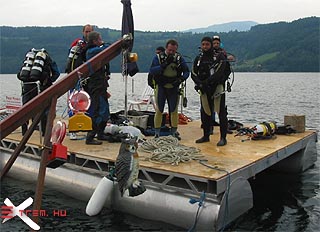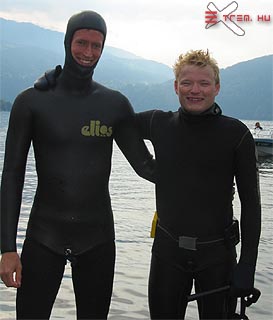Should I try to push my limits or stay on the safe side? Should I risk a blackout or an ear injury? If I do just want I can surely do, how do I improve? Difficult question that freedivers have to face. In the third part of our coverage of the Heart of Europe Feediving Open, you can read about that among many other things.
In the third and final part of our coverage of the Heart of Europe, Carinthian Freediving Invitational, the focus will be on the depth discipline, the Constant Weight competition.
 Scuba divers have so much more to carry |
It is also a fault on part of the media that we do not know enough about this sport. On my way to Millstätter Lake, I talked to some English folks and after I mentioned „freediving”, they asked me where they dive from, thinking it was a form of highdiving. Therefore, it is interesting to get to know how the freedivers got into this sport. The most common answer is that „I saw the Big Blue, and that‘ s when I realized that how cool it could be to be able to dive freely. There are also freedivers who „inherited” their love of the water from their scuba diver parents. In those countries, where underwater hockey and UW-rugby is very popular, some switch from those sports to freediving. And there are those, who have learnt about this sport only lately. One such guy is the Austrian Marcus Schrauder, who heard about freediving this winter. He saw a report about Christian Redl‘ s world record in dynamic under the ice, and he decided to learn more about this crazy sport. Half a year later, he became third in the Austrian Championships in Millstatt.
 The static gets exciting when they do not move for at least 6 mins |
It sounds complicated but it isn‘t
Even those, who know what Freediving is, often have problems with the different disciplines. Are they allowed to touch the role, to wear fins? Are they going down with their own power or are they using a sled? It is not as complicated as it might seem, but since freediving events are not broadcasted on television, it is harder to get informed about it. Well, my colleague had an idea after seeing the videos made at the Static event. He suggests that it should be used on channels focusing on relaxation. They could broadcast 5-6 hours of static live, since there is nothing more relaxing than freedivers floating motionless in the water for 5-8 minutes with total silence around them…OK, back to serious business. Let‘ s see what the boys and girls were doing in Millstätter Lake at the weekend.
There are altogether four types of depth disciplines according to the AIDA system. Free Immersion, Variable Weight, No Limit and Constant Weight. The situation is simple, because it is only the Constant Weight in which competitions are held – often in combination with the Static.
 Herbert wearing a monofin, two watches and a lanyard, to keep him close to the rope |
In Constant Weight, the freedivers have to dive down to the announced depth on their own power, and to come up in the same way. A rope is used to direct them, so that they can get down to their announced depth using the shortest way. There they have to find a tag, untie it and take it up to the surface as a proof. Of course, if a freediver realizes on the way down that he misjudged his physical strength, then he can turn around earlier. The freedivers wear a depth meter, so the judges can see how deep they went even if they come up without the tag. The term Constant Weight is derived from the rule that they cannot descend using weights to make their downwards journey quicker and leave them at the bottom. Moreover, they are also not allowed to touch the rope more than once, only when they untie the tag.
There are two categories in Constant Weight: with fins and without fins. When this article is written, the with fins world record is twice as deep as the other one. Both are held by the Austrian Herbert Nitsch, with –95 and –50 meters. He did both of them in Millstatt, at the site of the Carinthian Open, but not during the competition. He dived „only” –94 meters there. When he resurfaced, he was holding only a rubber ribbon in his hands, but no tag to prove that he indeed reached –94 meters. There was no underwater camera at –94 meters during his dive, but he was wearing a depth meter, so he could prove to the judges that he was down there. The second best depth at the competition was –64 meters by Hubert Maier.
Tactics and risks
Since the rope ends at the depth announced beforehand, the freedivers cannot go deeper, even if they feel they could. So this discipline is also about tactics. You have to know beforehand how much you want to risk. The second biggest depth announced was –71 meters by the Croatian champion, Zeljko Verdis. However, as you could read in our report about the Static competition, Zeljko was so devastated by his girlfriend‘s blackout in the Static the day before, that he could not sleep and he decided not to compete in the Constant Weight. His girlfriend, Melita, on the other hand, did, but he most probably regrets that by now. She stayed conscious, reached her announced –49 meters, but she made a mistake when she was turning around at –49m, she did not equalize well and she is believed to have torn her eardrum.
Herbert Nitsch knows a lot about the eardrum problem. He had it broken at the world championships in May, so I asked him about it after Melita resurfaced.
 Herbert inhales some oxygen, just to be on the safe side |
– I do not think Melita tore it. It would hurt so much more and it would also bleed.
– What caused it when you had that injury in Cyprus? Do you remember how it happened?
– It is hard to decide whether to turn back or to continue going down when you feel that you could have a problem with your eardrum. I made the wrong decision in Cyprus. On the way up, I knew it. I felt a hissing sound in my ear. Since the equilibration center is also in your ear, your brain tries to adapt to the new situation, you start to feel dizzy. You have only a little air left in your lungs and you are lucky, if you make it to the surface.
– How long does the healing process take?
– The eardrum welds in a couple of days but you should stay out of the water for at least a month. And even after that you should have it checked from time to time if you are going down deep.
Dreaming, underwater
 Andrea, two minutes after his blackout |
Melita, nonetheless, had great pain in her ear, but the Italian Andrea Richichi will not have great memories of the Constant competition either. He lost his motor control during Static, but he decided to compete anyway. He announced -57 m in the Constant Weight. As he told me afterwards, he felt that he should not have dived at all on that day since he had been sick. He wanted to dive to -45m only, but in the absence of lights he went too deep. He overrated his capabilities and the safety divers had to get him out of the water. When you see a blackout live for the first time, well, it is not a pleasant sight at all. In Andrea‘s case, he was dragged out of the water by the two safety divers, he blinked, his eyes went astray and he lost consciousness. A couple of seconds later, he made clicking sound and he started to breath again.
They laid him down on the platform and 2-3 minutes later he was chatting with me, like nothing had happened. I was curious what he felt during his blackout. „I do not remember much. Did I really faint? All I can remember was the suddenly I had this very pleasant feeling, like in a dream. And then I woke up on the platform.” Melita talked about a similar pleasant feeling after the lights went out for her in the Static.
 Two Danes, Jesper on the right |
Have fun
Before someone blames me for talking only about the injuries and problems, I am quick to note that the other divers had no sambas or blackouts during the Constant. Not everyone was reaching for the –70 meter mark, of course, but that was not the aim for the game. Everybody was trying to extend his or her own limits, and the –30 m personal bests were cheered as much as Herbert’s –94 meters.
One of the best in generating a great atmosphere was the Danish Jesper Pedersen. He even made the judges clap. Jesper, the jester had his moments even at the pre-event meeting the night before. He was curious whether there still have mermaids in the lake because he saw one last year. He also wanted to know whether the tag is lightened, because it is pitch dark at –100 meters in the Millstätter Lake. “How do you know? You are a 35 meter man.” – asked the organizer of the event, Harald Lautner. “I saw it on television” – came Jesper’s reply.
 The overall ranking of the event (overall, males, females) |
As you could see, the field was pretty international. Besides the Italian ragazzo and the Croatians, there were Hungarians, Germans and Austrians, there was a woman originally from the US, living in Germany (she became the Queen of the Lake), and the Danes driving for fourteen hours to get to Carinthia. The Danes left their two world record holders (Stig Severinsen and Peter Pedersen) at home, but training the new generation is also very important. We, Hungarians, would be extremely happy if we had 100 freedivers, and the population of Denmark is only fifth of that of Hungary. Here we have only about a dozen freedivers, from whom three were competing in Millstatt. The best of them, Jani Busi became the 8th best male diver.
As I pointed out at the beginning of the article, freediving competitions are not held every week. The next one, the Night Indoor event in Berlin, will be in November. The next competition in Millstatt, the 2nd Carinthian Night event will take place in March, 2004. Till then, we will surely have some world record attempts.


